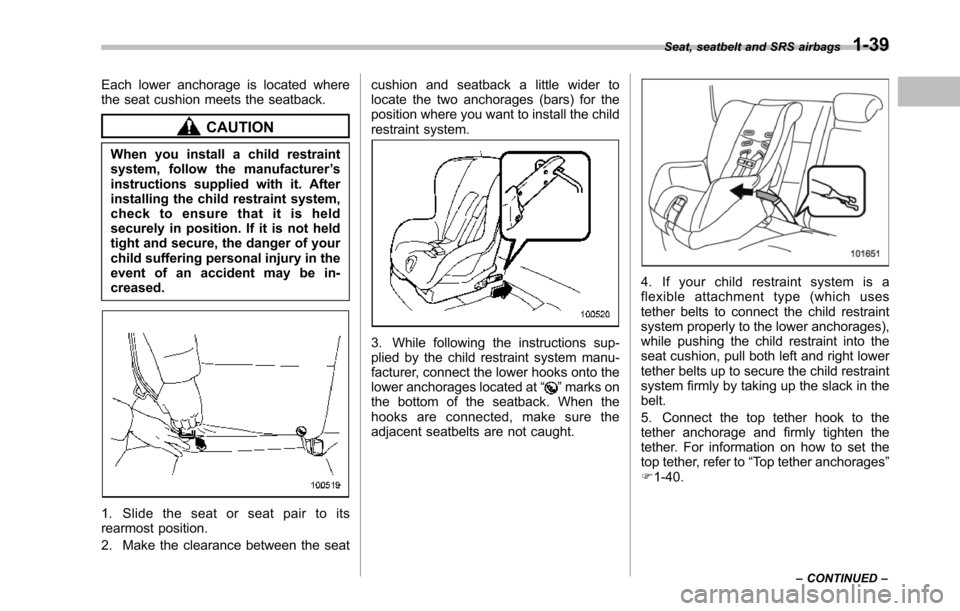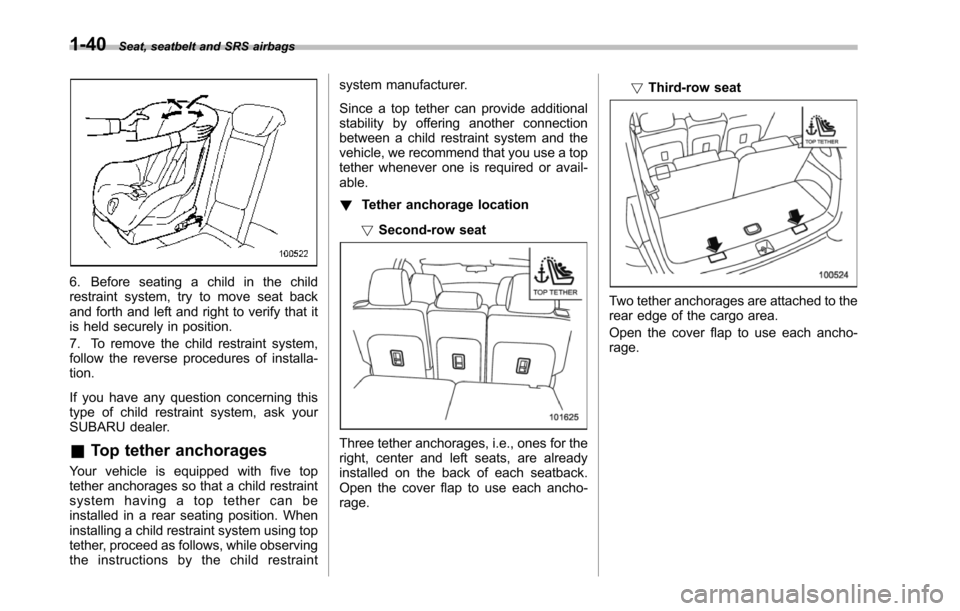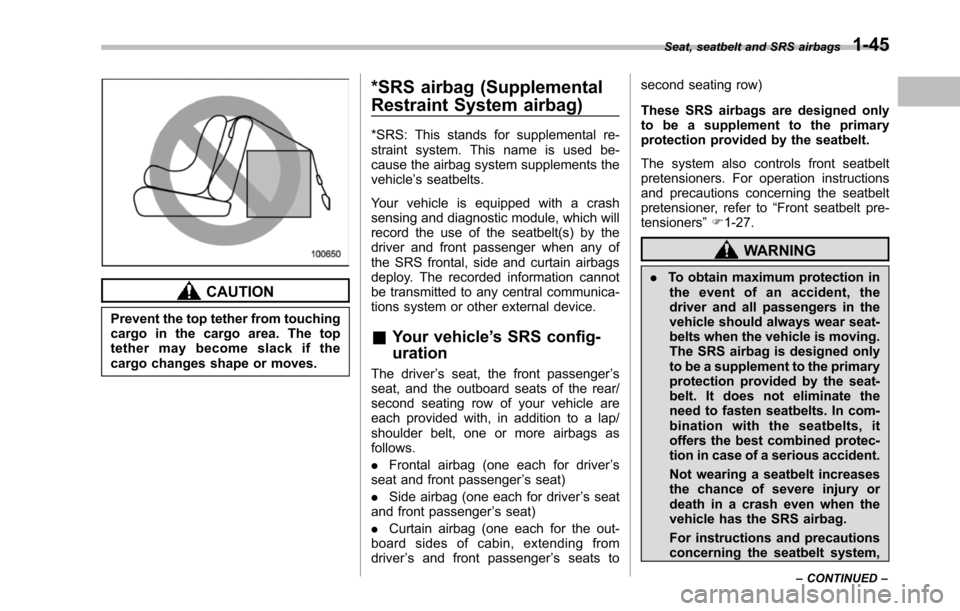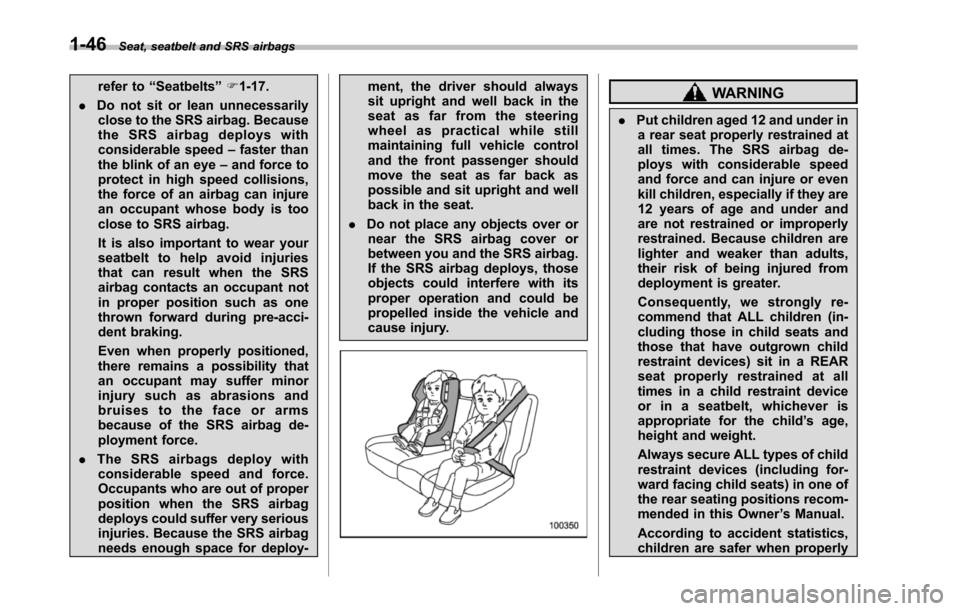Page 70 of 426

Each lower anchorage is located wherethe seat cushion meets the seatback.
CAUTION
When you install a child restraintsystem, follow the manufacturer’sinstructions supplied with it. Afterinstalling the child restraint system,check to ensure that it is heldsecurely in position. If it is not heldtight and secure, the danger of yourchild sufferingpersonal injury in theevent of an accident may be in-creased.
1. Slide the seat or seat pair to itsrearmost position.
2. Make the clearance between the seat
cushion and seatback a little wider tolocate the two anchorages (bars) for theposition where you want to install the childrestraint system.
3. While following the instructions sup-plied by the child restraint system manu-facturer, connect the lower hooks onto thelower anchorages located at“”marks onthe bottomof the seatback. When thehooks are connected, make sure theadjacent seatbelts are not caught.
4. If your child restraint system is aflexible attachment type (which usestether belts to connect the child restraintsystem properly to the lower anchorages),while pushing the child restraint into theseat cushion, pull both left and right lowertetherbelts up to secure the child restraintsystem firmly by taking up the slack in thebelt.
5. Connect the top tether hook to thetether anchorage and firmly tighten thetether. For information on how to set thetop tether, refer to“Top tether anchorages”F1-40.
Seat, seatbelt and SRS airbags1-39
–CONTINUED–
Page 71 of 426

1-40Seat, seatbelt and SRS airbags
6. Before seating a child in the childrestraint system, try to move seat backand forth and left and right to verify that itis held securely in position.
7. To remove the child restraint system,follow the reverse procedures of installa-tion.
If you have any question concerning thistype of child restraint system, ask yourSUBARU dealer.
&Top tether anchorages
Your vehicle is equipped with five toptether anchorages so that a child restraintsystem having a top tether can beinstalled in a rear seating position. Wheninstalling a child restraint system using toptether, proceed as follows, while observingthe instructions by the child restraint
system manufacturer.
Since a top tether can provide additionalstability by offering another connectionbetween a child restraint system and thevehicle, we recommend that you use a toptether whenever one is required or avail-able.
!Tether anchorage location
!Second-row seat
Three tether anchorages, i.e., ones for theright, centerand left seats, are alreadyinstalled on the back of each seatback.Open the cover flap to use each ancho-rage.
!Third-row seat
Two tether anchorages are attached to therear edge of the cargo area.
Open the cover flap to use each ancho-rage.
Page 72 of 426

!To hook the top tether
!Second-row outboard seat
1. Remove the head restraint at thewindow-sideseating position where thechild restraint system has been installedwith the lower anchorages or seatbelt; liftup the head restraint while pressing therelease button. Store the head restraint inthe cargo area. Avoid placing the headrestraint in the passenger compartment toprevent it from being thrown around in thepassenger compartment in a sudden stopor a sharp turn.
2. Confirm that there are no obstaclesaround the anchorages.
3. Fasten the top tether hook of the childrestraint system to the appropriate upperanchorage.
4. Tighten the top tether securely.
CAUTION
When the child restraint system is tobe secured using the top tether,pass the top tether under the headrestraint between the head restraintstay posts.
CAUTION
Be sure to install the top tether withthe head restraint raised to thehighest position. If the head re-straint is in any of the lower posi-tions, the top tether will touch thehead restraint and the resultingslack will prevent its secure installa-tion.
Seat, seatbelt and SRS airbags1-41
–CONTINUED–
Page 73 of 426
1-42Seat, seatbelt and SRS airbags
CAUTION
Do not route the top tether over thehead restraint. It may happen thatthe top tether cannot be fastenedtightly.
!Second-row center seat
1. Raise the head restraint to the highestposition at the seating position where thechild seat has been installed using theseatbelt or lower anchorages; lift up thehead restraint while pressing the releasebutton.
2. Confirm that there are no obstaclesaround the anchorages.
3. Fasten the top tether hook of the childrestraintsystem to the appropriate upperanchorage.
4. Tighten the top tether securely.
Page 74 of 426
CAUTION
When the child restraint system is tobe secured using the top tether,pass the top tether under the headrestraint between the head restraintstay posts.
CAUTION
Be sure to install the top tether withthe head restraint raised to thehighest position. If the head re-straint is in any of the lower posi-tions, the top tether will touch thehead restraint and the resultingslack will prevent its secure installa-tion.
CAUTION
Do not route the top tether over thehead restraint. It may happen thatthe top tether cannot be fastenedtightly.
!Third-row seat
1) Head restraint2) Lowering strap
1. Pull the lowering strap to lower thehead restraint.
Seat, seatbelt and SRS airbags1-43
–CONTINUED–
Page 75 of 426
1-44Seat, seatbelt and SRS airbags
2. Open the lid of the cargo area, thenremove the covers for the anchorages.
3. Fasten the top tether hook of the childrestraint systemto the appropriate upperanchorage.
4. Tighten the top tether securely.
CAUTION
Do not pass the top tether under thehead restraint. The top tether willtouch the head restraint and theresulting slack will prevent its se-cure installation.
CAUTION
Do not use the top tether with thehead restraint in a raised position,otherwise the top tether cannot befastened tightly.
Page 76 of 426

CAUTION
Prevent the top tether from touchingcargo in the cargo area. The toptether may become slack if thecargo changes shape or moves.
*SRS airbag (Supplemental
Restraint System airbag)
*SRS: This stands for supplemental re-straint system. This name is used be-cause the airbag system supplements thevehicle’s seatbelts.
Your vehicle is equipped with a crashsensing and diagnostic module, which willrecord the use of the seatbelt(s) by thedriver and front passenger when any oftheSRS frontal, side and curtain airbagsdeploy. The recorded information cannotbe transmitted to any central communica-tions system or other external device.
&Your vehicle’s SRS config-
uration
The driver’s seat, the front passenger’sseat, and the outboard seats of the rear/second seating row of your vehicle areeach provided with, in addition to a lap/shoulder belt, one or more airbags asfollows.
.Frontal airbag (one each for driver’sseat and front passenger’s seat)
.Side airbag (one each for driver’s seatand front passenger’s seat)
.Curtain airbag (one each for the out-board sides of cabin, extending fromdriver’s and front passenger’s seats to
second seating row)
These SRS airbags are designed onlyto be a supplement to the primaryprotection provided by the seatbelt.
The system also controls front seatbeltpretensioners. For operation instructionsand precautions concerning the seatbeltpretensioner, refer to“Frontseatbelt pre-tensioners”F1-27.
WARNING
.To obtain maximum protection inthe event of an accident, thedriverand all passengers in thevehicle should always wear seat-belts when the vehicle is moving.The SRS airbag is designed onlyto be a supplement to the primaryprotection provided by the seat-belt. It does not eliminate theneed to fasten seatbelts. In com-bination with the seatbelts, itoffers the best combined protec-tion in case of a serious accident.
Not wearing a seatbelt increasesthe chance of severe injury ordeath in a crash even when thevehicle has the SRS airbag.
For instructions and precautionsconcerning the seatbelt system,
Seat, seatbelt and SRS airbags1-45
–CONTINUED–
Page 77 of 426

1-46Seat, seatbelt and SRS airbags
refer to“Seatbelts”F1-17.
.Do not sit or lean unnecessarilyclose to the SRS airbag. Becausethe SRS airbag deploys withconsiderable speed–faster thanthe blink of an eye–and force toprotect in high speed collisions,the force of an airbag can injurean occupant whose body is tooclose to SRS airbag.
It is also important to wear yourseatbelt to help avoid injuriesthat can result when the SRSairbag contacts an occupant notin proper position such as onethrown forward during pre-acci-dent braking.
Even when properly positioned,there remainsa possibility thatan occupant may suffer minorinjury such as abrasions andbruises to the face or armsbecause of the SRS airbag de-ployment force.
.The SRS airbags deploy withconsiderable speed and force.Occupants who are out of properposition when the SRS airbagdeploys could suffer very seriousinjuries. Because the SRS airbagneeds enough space for deploy-
ment, the driver should alwayssit upright and well back in theseat as far from the steeringwheel as practical while stillmaintaining full vehicle controland the front passenger shouldmove the seat as far back aspossible and sit upright and wellback in the seat.
.Do not place any objects over ornear the SRS airbag cover orbetween you and the SRS airbag.If the SRS airbag deploys, thoseobjects could interfere with itsproper operation and could bepropelled inside the vehicle andcause injury.
WARNING
.Put children aged 12 and under ina rear seat properly restrained atall times. The SRS airbag de-ploys with considerable speedand force and can injure or evenkill children, especially if they are12 years of age and under andare not restrained or improperlyrestrained. Because children arelighter and weaker than adults,their risk of being injured fromdeployment is greater.
Consequently, we strongly re-commend that ALL children (in-cluding those in child seats andthose that have outgrown childrestraintdevices) sit in a REARseat properly restrained at alltimes in a child restraint deviceor in a seatbelt, whichever isappropriate for the child’s age,height and weight.
Always secure ALL types of childrestraint devices (including for-ward facing child seats) in one ofthe rear seating positions recom-mended in this Owner’s Manual.
According to accident statistics,children are safer when properly